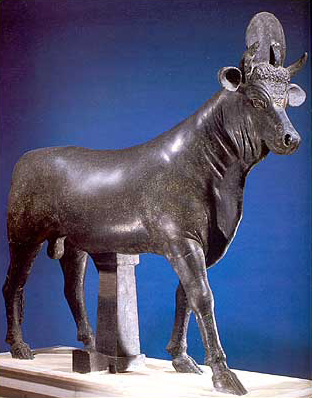
APIS, a sacred bull worshipped at Memphis from the earliest period, having probably been introduced into the religious system as early as the 2nd dynasty by the king Kaiechos, who instituted the worship of Apis and the bull Mnevis.
His name in hieroglyphs was Hapi, and meant "the hidden," as he had to be discovered amidst the cattle, which was done by certain diacritical marks. According to the hieroglyphic inscriptions which accompany his form, he was the second birth or living incarnation of the god Ptah, the Egyptian Hephaestos or Vulcan. Apis is first mentioned and appears in the monuments of the 4th dynasty. The two bulls Apis and Mnevis are considered to have respectively represented the moon and sun, and seem both to have been buried at Memphis.
He was supposed to have been born of a virgin cow, rendered pregnant by a moonbeam or a flash of lightning. The mother of Apis, according to Strabo, had a part of the temple of the Apis reserved for her use; and the hieroglyphic inscriptions record a prophet or priest attached to her service. On the monuments she shares the honours of the bull, and is represented under the attributes of Athor as a goddess with a cow’s head. This cow had her especial name, these animals having each a separate appellation. According to the Greek writers Apis was the image of Osiris, and worshipped because Osiris was supposed to have passed into a bull, and to have been soon after manifested by a succession of these animals. The hieroglyphic inscriptions identify the Apis with Osiris, adorned with horns or the head of a bull, and unite the two names as Hapi-Osor, or Apis Osiris. According to this view the Apis was the incarnation of Osiris manifested in the shape of a bull. But besides this title, the monuments style Apis the son of Ptah, who was supposed to be his father by the sacred cow, or the second life of Ptah. Other monuments, indeed, declare him to have had no father, and to have been Onnophris or Osiris, but this conflict of ideas must have arisen from his material and spiritual nature, uniting the soul of Osiris or Ptah mystically with the sacred animal. Besides the mother of the Apis, a cow was annually exhibited to him decorated with the same insignia -- that is, a disk between the horns and a housing on the back, to judge from the insignia found on the bronze figures of the Apis -- and then slaughtered the same day, for no issue of the divine animal was permitted to exist.
According to other authorities several cows were kept in the Apeum on the announcement of the birth of an Apis, the sacred scribes and priests proceeded to verify the characters of the calf. The marks of the Apis were a black coloured hide, with a white triangular spot on the forehead, the hair arranged in the shape of an eagle on the back, and a knot under the tongue in shape of a scarabaeus, the sacred insect and emblem of Ptah, a white spot resembling a lunar crescent at his right side. These marks have been supposed to be for the most part certain arrangements of the hairs of the hide as seen in some animals. A house was built to the calf Apis facing the east, in which for four months he was nourished with milk. When he had grown up he was conducted, at the time of the new moon, to a ship by the sacred scribes and prophets, and conducted to the Apeum at Memphis, where there were courts, places for him to walk in, and a drinking fountain. According to Diodorus, he was first led to Nilopolis, and kept there 40 days, then shipped in a boat with a gilded cabin to Memphis, and he was there allowed to be seen for 40 days only by women, who exposed themselves to him. Like all the sacred animals his actions were oracular, and he had two chambers, his passage into one of which was deemed fortunate, and into the other unlucky. Thus the licking the garments of a visitor was supposed to prognosticate a tranquil but short life, and his refusal of the food offered to him by the hand of Germanicus, the approaching death of that hero. The actions of the children who played around his shrine or accompanied his processions were also considered oracular. The day of his birth was kept as an annual festival.
His life was not allowed to exceed 25 years, and should it have attained that maximum reckoned from the date of his enthronisation, the Apis was killed and thrown into a well, in which the priests asserted he had precipitated himself. This well was known to no one, and no one was allowed to reveal the place of burial. If the Apis died before the 25 years he received a splendid burial at Memphis in the Serapeum, for after death he was called the osor-hapi, or Serapis. This funeral was expensive; his body was placed in a barge, and accompanied by a procession of a Bacchanalian character, passing through the brazen doors of Memphis. As universal joy prevailed at his discovery, so his death threw all Egypt into a general mourning, and every one shaved off his beard. This mourning continued till the discovery of another Apis.